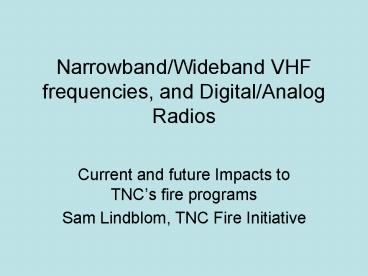NarrowbandWideband VHF frequencies, and DigitalAnalog Radios - PowerPoint PPT Presentation
1 / 12
Title:
NarrowbandWideband VHF frequencies, and DigitalAnalog Radios
Description:
Current and future Impacts to TNC's fire programs. Sam Lindblom, TNC Fire Initiative ... Continue to purchase analog radios unless you have a big budget ... – PowerPoint PPT presentation
Number of Views:53
Avg rating:3.0/5.0
Title: NarrowbandWideband VHF frequencies, and DigitalAnalog Radios
1
Narrowband/Wideband VHF frequencies, and
Digital/Analog Radios
- Current and future Impacts to TNCs fire programs
- Sam Lindblom, TNC Fire Initiative
2
The Issue
- Increased radio frequency usage (more users)
- Limited bandwidth available on the VHF spectrum
- Much more conflict between users
- Getting walked on
- Potential increased regulation by the FCC
3
The Solution
- Convert to Narrow Band radio frequencies and
equipment - More on equipment later....
- First, lets look at the technology and the issue
in more detail
4
What is Narrow Band?
- Narrow band frequencies use ½ the bandwidth of
wide-band - Normal wideband spacing is 25 Khz
- Narrowband spacing is 12.5 Khz
- For example, the TNCFIRE frequency is 151.625.
Normally, the next frequency up would be 151.650.
In narrow band, the next frequency is 151.6375 - Narrow banding essentially doubles the number of
available frequencies in the VHF Business
spectrum (148-174 Mhz)
5
Sounds Great, right?
- PROS of Narrowband
- Less traffic on currently shared frequencies
- Reduces the need to use tone/code guards
- CONS of Narrowband
- Operating wideband in a narrowband environment
can cause problems - Requires specific radio equipment
- Could be costly (more on that in a minute)
- Its likely to be a long time before the general
public will be forced to use narrowband and all
wideband radios are obsolete
6
(No Transcript)
7
Why would I want to convert to Narrowband radios?
- If you regularly burn with federal partners, you
will likely have to convert sooner than most - If you experience significant radio traffic where
you work, narrowband could help (but only if
everyone converts) - If you intend to participate on large wildland
fire incidents of any kind
8
The FCC and Narrowbanding
- The Federal Communications Commission mandated
that all federal agencies convert by 2005. This
mandate was lifted until further notice - FCC does not currently have a time schedule in
place to change the general licenses that we have
now.
9
Equipment
- Some existing radios that we have can be
programmed to narrowband (most likely so if they
were purchased in the last few years) - Bendix King EPH and GPH radios are OK
- At this point, you should avoid radios that will
not work on narrowband frequencies - Most radios require programming each individual
frequency/channel as narrow or wide - Narrowband radios alone dont significantly
increase costs
10
What about Digital?
- The problem with Analog and Narrowband
frequencies - Analog radios have a harder time sending and
receiving narrowband frequencies, reducing their
effective radiated power. - Certain analog radios can lose up to ½ of their
transmit distance.
11
What about Digital?
- Digital radios overcome this problem with a
better capacity to process narrowband frequencies - They dont typically suffer from the same loss in
effective radiated power as analog. - Some digital radios using narrowband can
theoretically transmit further than their analog
counterparts using wideband - Digital radios are expensive
- GPH Bendix King (Analog) is 500
- DPH Bendix King (Digital) is 1200
12
Recommendations
- Continue to purchase analog radios unless you
have a big budget - Do not purchase radios that cannot process
narrowband frequencies - Know how to program your radios
- Know if you are working in a narrowband
environment - Ask all of your local cooperators
- Establish a communications plan if you contribute
to local emergency response.































